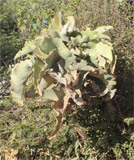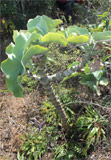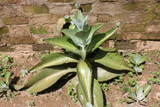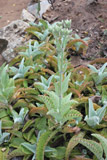|
|
||
An abridged version of this article appeared in the "Hortuskrant" of September 2012 of the "Botanical Garden of Amsterdam"
door Fred Triep
| They like long nights, the succulent plants of the genus Kalanchoe. One species of Kalanchoe is in the Hortus in the Three Climates glasshouse. Fred Triep throws light upon this and other species of this genus |
|
Kalanchoe is a genus of succulent plants of the family Crassulaceae with about two hundred species. This family contains leaf succulents (plants with thickened leaves) with radially symmetrical flowers consisting of 5 or 4 parts. This plant family occurs worldwide in places where prolonged physiological drought (porous soils, semi-deserts) exists. The greatest diversity can be found in Mexico, South Africa, Madagascar, Macaronesia (Azores, Madeira, Canary Islands, Cape Verde) and the Himalayas.
Thick and hairy
The genus
Kalanchoe comes mainly from South Africa or Madagascar. Unlike the rest of the
family the flowers
are
here in four parts, with the flower petals halfway
grow
together into a
tube. These are all herbs or shrubs. Kalanchoe
beharensis
('Elephant's
ear ') is a shrub with can
get
the
proportions of a tree. I want
mainly
to discuss this
shrub, because
it
is present in the
desert area of the Three
Climate
glasshouse of the
Botanical
Garden.
It
grows in the
south of Madagascar. This plant has large, thick and hairy leaves, which resist
damage of
glutton.
Rich flowering?
Many plants of this genus are grown as ornamental plants, such as Kalanchoe tomentosa ('pussy ears' ), also from Madagascar, where he grows on bare rocks ('inselberge') on the plateau. Also Kalanchoe blossfeldiana ('Christmas Kalanchoe' or Flaming Katy ') is widely cultivated. He is sold as rich flowering houseplant. In order to get him again in bloom at home, he requires a strict regime of long nights. This will rarely succeed in a living room. In Madagascar, this plant is known from a single place in the north.
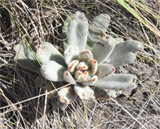 |
Click on the thumbnails if you want to see large
photos
Left: Kalanchoe tomentosa,
photographed at Ambatofinamdrahana |
Mother of thousands
An interesting group of this genus are the plants of the subgenus Bryophyllum, which previously was considered as a separate genus. These plants can form vegetative progeny, due to developing of small plants on the blade edges. These plants drop after some time and take roots. A famous plant from this subgenus is Kalanchoe daigremontiana ('mother of thousands'), also grown as ornamental plants. The thick triangular leaves of this species are at the bottom purple spotted.
Special metabolism
On Kalanchoe beharensis has been done investigations about the metabolism. One has discovered there the CAM metabolism (Crassulacean Acid Metabolism), that seemed to occur later in many plants of the family Crassulaceae and other xerofyten (drought resistant plants). These plants keep their stomata closed during the day, to prevent dehydration. The carbon dioxide that they need for their photosynthesis, they take it in at night through the stomata. It is then temporarily bonded to an organic acid, in order to be released again during the day and to be included in the process of photosynthesis.
Short day plants
Most of the Kalanchoe species are short-day plants. This means that they will flourish in a period of the year with short days. In reality it is not the length of the light period decisive for the bloom, but that of the dark period.
Literatuur
Kalancho beharensis- Wikipedia, the free encyclopedia
http://en.wikipedia.org/wiki/Kalanchoe_beharensis
Kalanchoe daigremontiana - Wikipedia
http://nl.wikipedia.org/wiki/Kalanchoe_daigremontiana
Crassulacean Acid Metebolism
http://en.wikipedia.org/wiki/Crassulacean_acid_metabolism
This page is newly created on Thursday 6 September 2012.
![]()
For additions or comments, please send me an email:
| Terug naar (return to): | Return to: |

